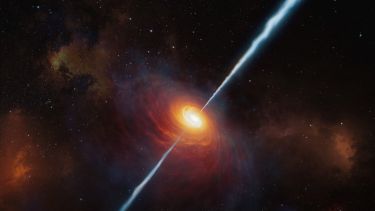- First discovered 60 years ago, quasars can shine as brightly as a trillion stars packed into a volume the size of our Solar System, but until now it has remained a mystery what could trigger such powerful activity
- By observing 48 galaxies that host quasars and comparing them to over 100 non-quasar galaxies, scientists discovered that the phenomenon is ignited by galaxies colliding
- When two galaxies collide, gravitational forces push huge amounts of gas towards supermassive black holes at the centre of the remnant galaxy system that results from the collision – just before the gas is consumed by the black hole, it releases extraordinary amounts of energy in the form of radiation, resulting in a quasar
- The Milky Way is likely to experience its own quasar when it collides with the Andromeda galaxy in roughly five billion years’ time
Scientists have unlocked one of the biggest mysteries of quasars – the brightest, most powerful objects in the Universe – by discovering that they are ignited by galaxies colliding.
First discovered 60 years ago, quasars can shine as brightly as a trillion stars packed into a volume the size of our Solar System. In the decades since they were first observed, it has remained a mystery what could trigger such powerful activity. New work led by scientists at the Universities of Sheffield and Hertfordshire has now revealed that it is a consequence of galaxies crashing together.
The collisions were discovered when researchers, using deep imaging observations from the Isaac Newton Telescope in La Palma, observed the presence of distorted structures in the outer regions of the galaxies that are home to quasars.
Most galaxies have supermassive black holes at their centres. They also contain substantial amounts of gas – but most of the time this gas is orbiting at large distances from the galaxy centres, out of reach of the black holes. Collisions between galaxies drive the gas towards the black hole at the galaxy centre; just before the gas is consumed by the black hole, it releases extraordinary amounts of energy in the form of radiation, resulting in the characteristic quasar brilliance.
The ignition of a quasar can have dramatic consequences for entire galaxies – it can drive the rest of the gas out of the galaxy, which prevents it from forming new stars for billions of years into the future.
This is the first time that a sample of quasars of this size has been imaged with this level of sensitivity. By comparing observations of 48 quasars and their host galaxies with images of over 100 non-quasar galaxies, researchers concluded that galaxies hosting quasars are approximately three times as likely to be interacting or colliding with other galaxies.
The study has provided a significant step forward in our understanding of how these powerful objects are triggered and fuelled.
Professor Clive Tadhunter, from the University of Sheffield’s Department of Physics and Astronomy, said: “Quasars are one of the most extreme phenomena in the Universe, and what we see is likely to represent the future of our own Milky Way galaxy when it collides with the Andromeda galaxy in about five billion years.
“It’s exciting to observe these events and finally understand why they occur – but thankfully Earth won’t be anywhere near one of these apocalyptic episodes for quite some time.”
Quasars are important to astrophysicists because, due to their brightness, they stand out at large distances and therefore act as beacons to the earliest epochs in the history of the Universe. Dr Jonny Pierce, Post-Doctoral Research Fellow at the University of Hertfordshire, explains:
“It’s an area that scientists around the world are keen to learn more about – one of the main scientific motivations for NASA’s James Webb Space Telescope was to study the earliest galaxies in the Universe, and Webb is capable of detecting light from even the most distant quasars, emitted nearly 13 billion years ago. Quasars play a key role in our understanding of the history of the Universe, and possibly also the future of the Milky Way”.
The paper can be viewed in full here.
Contact
For further information please contact:



